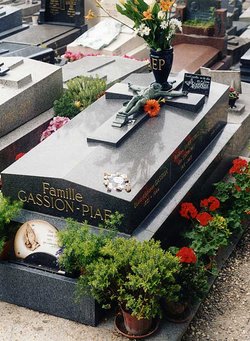|
|
Piakbookcover.jpg
Édith Piaf (December 19, 1915 - October 11, 1963) was one of France's most beloved singers and a national icon. Her music reflected her tragic life, with her specialty being the poignant ballad presented with a heartbreaking voice. The most famous songs performed by Piaf were La Vie en Rose (1946), Milord (1959), and Non, Je Ne Regrette Rien (1960).
She was born Édith Giovanna Gassion in Paris, France; her mother worked as a cafe singer and her father was a well-known travelling acrobat. Abandoned by her mother, she was raised by her paternal grandmother, who ran a brothel in Normandy. From age 3 to 7, she was blind. As part of Édith Piaf's legend, she allegedly recovered her sight after her grandmother's prostitutes went to a pilgrimage to Saint Thérèse de Lisieux. Later she lived for a while with her alcoholic father, whom she left by age 16 to become a street singer in Paris.
In 1935, Édith was discovered by the nightclub owner Louis Leplée whose club was frequented by the upper and lower classes alike. He convinced Édith to sing despite her extreme nervousness, and gave her the nickname that would stay with her for the rest of her life: La Môme Piaf (The Little Sparrow). From this she took her stage name. Her first record was produced in the same year. Shortly thereafter, Leplée was murdered and Piaf was accused of being an accessory; she was acquitted.
In 1940, Jean Cocteau wrote the successful play Le Bel Indifférent for her to star in. She began to make friends with famous people, such as the actor Maurice Chevalier and the poet Jacques Borgeat. She wrote the lyrics of many of her songs, and collaborated with composers on the tunes.
Her signature song, La Vie en Rose, (that was voted a Grammy Hall of Fame Award in 1998) was written in the middle of the German occupation of Paris in World War II. During this time, she was in great demand and very successful. Singing for high-ranking Germans at the One Two Two Club earned Édith Piaf the right to pose for photos with French prisoners of war, ostensibly as a morale-boosting exercise. Once in possession of their celebrity photos, prisoners were able to cut out their own images and use them in forged papers as part of escape plans. Today, Édith Piaf's association with the French Resistance is well known and many owe their lives to her. After the war, Piaf toured Europe, the United States, and South America, becoming an internationally known figure. Her popularity in the U.S. was such that she appeared on the Ed Sullivan Show eight times.
She helped to launch the career of Charles Aznavour, taking him on tour with her in France and the United States.
Piaf had one child, a daughter, Marcelle, who died at the age of two in 1935; the child's father was Louis Dupont. The great love of Piaf's life, the boxer Marcel Cerdan, died in 1949. Piaf was married twice. Her first husband was Jacques Pills, a singer; they married in 1952 and divorced in 1956. Her second husband, Theophanis Lamboukas (a.k.a. Théo Sarapo), was a hairdresser-turned-singer and actor, and was twenty years younger than Piaf; they married in 1962.
In 1951 she was in a car accident and thereafter had difficulty breaking a serious morphine habit.
The Paris Olympia is the place where Édith Piaf achieved fame and where, just a few months before her death, she gave one of her most memorable concerts while barely able to stand. In early 1963, Édith recorded her last song, L'homme de Berlin.
Piaf died of cancer in Cannes on October 11, 1963 at the age of only 47, the same day as her friend Jean Cocteau. She was buried in Père Lachaise Cemetery, Paris. Although forbidden a Mass by the Roman Catholic archbishop of Paris (because of her lifestyle), her funeral procession drew hundreds of thousands of mourners onto the streets of Paris and the ceremony at the cemetery was jammed with more than forty thousand fans. Charles Aznavour recalled that Piaf's funeral procession was the only time, since the end of World War II, that Parisian traffic came to a complete stop.
There is a museum dedicated to Piaf, the Musée Édith Piaf (http://www.paris.org/Musees/Piaf/info.html) at 5, rue Crespin du Gast, 75011, Paris.
Today she is still remembered and revered as one of the greatest singers France has ever produced. Her life was one of sharp contrasts: the range of her fame as opposed to her tragic personal life, and her fragile small figure on stage with the resounding power of her voice.
See also
External links
- Les conquêtes de Piaf (http://www.lehall.com/galerie/piaf/index.htm)cy:Édith Piaf
de:Edith Piaf es:Edith Piaf eo:Edith PIAF fi:Édith Piaf fr:Édith Piaf it:Edith Piaf he:אדית פיאף nl:Edith Piaf no:Édith Piaf pl:Edith Piaf ro:Edith Piaf ru:Пиаф, Эдит sv:Edith Piaf tr:Edith Piaf

